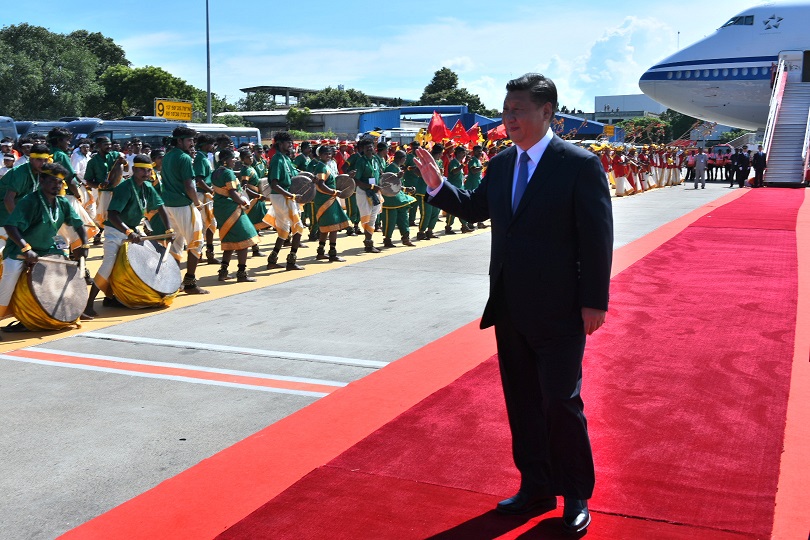
By: LakshmiPS
Chinese President Xi Jinping arrived in southern India on Friday for talks with Indian Prime Minister Narendra Modi to try to halt a slide in ties over the disputed Himalayan region of Kashmir amid scattered anti-China protests from Tibetan groups.
China and its all-weather ally Pakistan have been angered by India‘s decision two months ago to revoke the special status of the part of Kashmir it controls, which was accompanied by a crackdown on dissent.
India says it is an internal matter aimed at developing the region and there was no room for a third country to be involved, after Xi said he was watching the situation closely and assured Pakistan of Chinese support.
In a move to tighten its grip on Jammu and Kashmir, parts of which are claimed by Pakistan and China, India, in early August, dropped a constitutional provision that allowed the country’s only Muslim-majority state to make its own laws.
Xi arrived on Friday in the southern city of Chennai where Modi was to take him on a tour of the nearby Shore Temple dating back to the seventh and eighth centuries when regional kingdoms had direct ties with Chinese provinces.
Ahead of his arrival, police detained the chief of the Tibetan Youth Congress, Gonpo Dhondup, and 11 Tibetan students in several locations, including at the airport and a highway leading to the summit venue.
“We want freedom,” shouted Dhondup, as he was wrestled away by six policemen in a video shared by the Tibetan Youth Congress. He was pushed into an autorickshaw and taken away by police.
Two Tibetan activists, both women, staged a protest inside Chennai airport, holding a banner that read: “Xi Jinping Stop Occupation in Tibet – Free Tibet.”
China sent troops into remote, mountainous Tibet in 1950 in what it officially terms a peaceful liberation and has ruled there with an iron fist ever since.
The Dalai Lama, Tibet’s spiritual leader, fled to India in 1959 after a failed uprising against Chinese rule. China brands him a dangerous reactionary who seeks to split off nearly a quarter of the Chinese landmass.
The 1989 Nobel Peace laureate denies the charge and says he seeks greater rights for Tibetans.
The Dalai Lama and the so-called Tibetan government-in-exile have been based in the northern Indian hill town of Dharamsala for decades, but India has been careful not to let Tibetans embarrass visiting Chinese leaders.
TERRITORIAL DISPUTE
Indian officials say they expect China to respect its core concerns in the same way, including over the issue of Kashmir.
Modi and Xi will be aiming to move forward on a set of confidence-building measures during the informal summit in Mamallapuram, a short distance from Chennai, an Indian source briefed on the discussions said.
India and China share a 3,500 km (2,200 mile) border, over which they went to war in 1962. Its course remains unresolved despite more than 20 rounds of talks.
The border has been largely peaceful, but there have been occasional stand-offs between soldiers from the two Asian giants. The measures on the table include more border trade, tourism and even joint military patrols to boost trust, said the source.
“Priority will be given to enhancing confidence-building measures and people-to-people exchanges,” a second government source said.
Modi and Xi will also discuss India‘s ballooning trade deficit with China and the question of allowing Chinese telecoms equipment maker Huawei into India‘s 5G network.
“Xi will have an in-depth communication with Modi on issues that have overall, long-term and strategic significance on bilateral relations, set the tune and guide the direction for future development of the ties,” Chinese state media quoted Vice Foreign Minister Luo Zhaohui as saying.
Xi will head to Nepal on Saturday, the first Chinese president to visit the buffer state between India and China in 22 years.
“We need to make greater efforts to develop a Multi-dimensional Connectivity Network across the Himalayas,” he wrote in an article in three Nepali newspapers.
China has been building infrastructure in Nepal along with other South Asian countries as part of Xi’s signature Belt and Road Initiative, raising disquiet in India which long saw countries such as Nepal as part of its sphere of influence.
But C. Raja Mohan, an influential foreign affairs commentator, said China had pulled way ahead of India after decades of rapid growth and that limited Delhi’s options.
China’s economy was nearly five times larger than that of India and its annual defence spending four times larger, he wrote in a column in the Indian Express.
“This power imbalance translates into an unpleasant fact on the diplomatic front – that China is under no pressure to please India,” Mohan said.
(Reuters)
